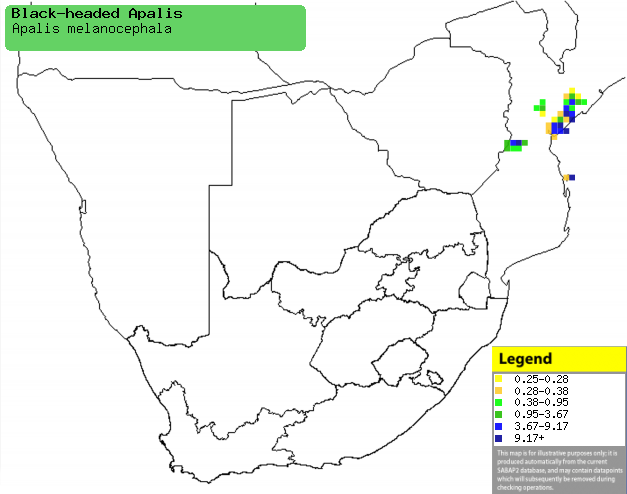|
Apalis melanocephala
(Black-headed apalis)
Swartkopkleinjantjie [Afrikaans]; Tanzania-apalis [Dutch];
Apalis à tête noire [French]; Schwarzkopf-fFeinsänger [German];
Apalis-de-cabeça-preta [Portuguese]
Life
> Eukaryotes >
Opisthokonta
> Metazoa (animals) >
Bilateria >
Deuterostomia > Chordata >
Craniata > Vertebrata (vertebrates) > Gnathostomata (jawed
vertebrates) > Teleostomi (teleost fish) > Osteichthyes (bony fish) > Class:
Sarcopterygii (lobe-finned
fish) > Stegocephalia (terrestrial
vertebrates) > Tetrapoda
(four-legged vertebrates) > Reptiliomorpha > Amniota >
Reptilia (reptiles) >
Romeriida > Diapsida > Archosauromorpha > Archosauria >
Dinosauria
(dinosaurs) > Saurischia > Theropoda (bipedal predatory dinosaurs) >
Coelurosauria > Maniraptora > Aves
(birds) >
Order: Passeriformes > Family: Cisticolidae
> Genus: Apalis
Distribution and habitat
Occurs from Kenya through Tanzania to southern Africa. Here
it is locally common in central Mozambique bordering on south-eastern Botswana,
preferring tangled creepers in the canopy of coastal evergreen forest, or
Afromontane forest strips along rivers. It also occupies dry forest with sandy
soil, coastal scrub forest and stunted miombo (Brachystegia) woodland.
|
 |
|
Distribution of Black-headed apalis in southern Africa,
based on statistical smoothing of the records from first SA Bird Atlas
Project (©
Animal Demography unit, University of
Cape Town; smoothing by Birgit Erni and Francesca Little). Colours range
from dark blue (most common) through to yellow (least common). |
Food
It mainly eats, especially grasshopper nymphs (Orthoptera),
flies (Diptera)
and
caterpillars. It does most of its foraging in the canopy, gleaning prey
from leaves, flowers and twigs and often joining mixed-species foraging flocks.
Breeding
- The nest is an oval-shape with a side entrance built of fine lichen such
as old-mans-beard-lichen (Usnea). It is typically attached with
spider web to twigs in the foliage of trees, about 4-7 metres above ground.
- Egg-laying season is around November.
- It lays 1-3 pale greenish eggs, which are boldly marked with specks of
chestnut and brown.
Threats
Not threatened, although its range has been slowly
decreasing in southern Africa.
References
-
Hockey PAR, Dean WRJ and Ryan PG 2005. Roberts
- Birds of southern Africa, VIIth ed. The Trustees of the John Voelcker
Bird Book Fund, Cape Town.
|
